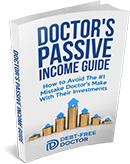Why a Dividend Investing Strategy Belongs in Your Portfolio
When I first became a periodontist, I thought I had made it—good income, steady work, and a clear path forward. But a skiing accident that injured my wrist shook everything. I realized how fragile my financial security was—and that I was only one accident away from being unable to provide for my family.
That moment changed the way I thought about money. I began building passive income streams. Real estate investing (mainly syndications) became my main focus, and over time, it gave me more freedom.
But I’ve always looked for additional tools that help me make work optional. That’s where a dividend investing strategy comes in.
Let’s walk through how it works and how you can start building a reliable stream of dividend income.
Don’t Miss Any Updates. Each week I’ll send you advice on how to reach financial independence with passive income from real estate.
Sign up for my newsletterWhat Is Dividend Investing?
Dividend investing is the strategy of buying stocks, mutual funds, or exchange-traded funds (ETFs) that pay dividends—cash payments given to shareholders from a company’s profit.
These dividend payments are typically sent out quarterly or monthly and act as a reward for owning a piece of the company. Some companies also offer special dividends, which are one-time payouts based on extra profits.
The goal of a dividend investing strategy is to create a steady stream of income, not just rely on stock price increases or capital gains.
Why You Need a Dividend Investing Strategy
If you’re a dentist, doctor, or other high-income earner, your income probably depends on your time and effort. That’s risky.
Dividend investing lets your money work for you. It adds a second income stream—one that comes in regularly, whether you’re working or not. This can be helpful during market downturns and uncertain times.
Many investors focus only on growing their net worth (because that’s what our advisors want us to do…..keep working to fee us to death!). But building dividend income helps you move closer to time freedom, where you’re not stuck trading time for money.
Types of Dividend-Paying Stocks
You can’t just buy any stock and expect income. You want to choose from proven, reliable dividend-paying companies. These often fall into a few categories:
-
Dividend Growth Stocks: These are companies that increase their dividend payouts every year.
-
High-Yield Stocks: These offer higher dividend yields, but you must watch out for risk. A high yield can be a red flag if the company is struggling.
-
Dividend Aristocrats: These are companies in the S&P 500 Index that have raised their dividends for 25+ consecutive years.
-
REITs: Real estate investment trusts are legally required to pay most of their profits out as cash dividends. A good option for immediate income.
Each of these offers a different blend of risk tolerance, long-term growth, and regular income.
Best Dividend ETFs for Passive Income
If you don’t want to research individual companies, you can invest in dividend ETFs. These are baskets of dividend stocks you can buy with one click.
Here are some popular options:
| Ticker | Strategy / Focus | Investor Appeal |
|---|---|---|
| JEPI | Income-focused ETF using equity-linked notes and covered calls | High yield, monthly income |
| SCHD | Dividend growth ETF with quality U.S. companies | Long-term dividend growth |
| QQQI | Tech exposure with qualified dividends | Tech-heavy, long-term capital appreciation |
| SPYI | S&P 500 exposure with options overlay strategy | Core index investing with enhanced income |
| O | Monthly dividend REIT with strong payout consistency | Real estate exposure and reliable monthly income |
These funds make it easier to build a diversified portfolio of dividend stocks without picking winners on your own.
How Dividend Payments Work
Here’s how dividend investing works in practice:
Let’s say you buy 100 shares of a company that pays a quarterly dividend of $0.60 per share. You’ll earn $60 every quarter, or $240 per year, just for holding those shares.
You qualify for a dividend if you own the stock before the ex-dividend date. The company will also set a record date and payment date to finalize when and how the dividend is paid.
Some companies offer Dividend Reinvestment Plans (DRIPs), which automatically reinvest your dividends into additional shares—a great way to grow your investment over time without any extra work.
How to Build a Dividend Portfolio
Here’s a step-by-step guide to building your dividend portfolio:
-
Set clear financial goals. Do you want income now, or growth for later?
-
Know your risk tolerance. If you’re close to retirement, you might want safer stocks. Younger investors can afford more risk.
-
Choose quality companies. Look for a history of consistent dividends, strong profits, and low debt.
-
Check the dividend payout ratio. If it’s too high (over 80%), the dividend may not be sustainable.
-
Diversify across industries—healthcare, utilities, financial services, and technology.
-
Use ETFs or mutual funds to reduce risk and simplify your investing.
Tax Implications of Dividend Investing
Dividends aren’t free from taxes.
-
Qualified dividends are taxed at lower capital gains rates.
-
Ordinary dividends are taxed at regular income rates.
-
If you hold dividend stocks in tax-advantaged accounts like a Roth IRA or Traditional IRA, your earnings can grow tax-free or tax-deferred.
If you’re investing through a brokerage account, be aware of transaction costs and the tax implications each year.
Avoiding Dividend Traps
Not all dividends are created equal. Some companies offer tempting high dividend yields, but at the cost of long-term stability.
This is called a dividend trap.
A few warning signs:
-
A high payout ratio with declining net income
-
Too much debt
-
A falling share price that makes the dividend look higher than it really is
-
Sudden leadership changes or shaky business models
Stick with companies that have free cash flow, a long history of paying dividends, and stable earnings.
Dividend Reinvestment: Compound Your Growth
If you don’t need the income right away, consider reinvesting your dividends.
Using a DRIP, your earnings are used to buy more shares automatically. Over time, this compounds your returns and increases your annual dividend payment without you doing a thing.
The earlier you start, the more powerful this can be. For many dividend investors, this strategy turns small income streams into large ones over time.
When a Dividend Investing Strategy Works Best
A dividend investing strategy is best suited for:
-
People who want passive income
-
Those nearing or in retirement
-
High-income professionals who want to diversify
-
Investors looking for long-term growth with less risk than pure growth stocks
It can also help during market downturns, since companies that pay reliable dividends are usually more stable than fast-growing tech startups.
Is This Strategy Right for You?
If you’re looking for a flashy way to get rich quick, dividend investing probably isn’t it.
But if you want to slowly build a reliable stream of income, diversify your investments, and move toward making work optional, then this is a smart move.
You don’t need to go all in. Start small. Add a dividend ETF to your portfolio. Buy a few dividend growth stocks. Reinvest your earnings. Watch it grow.
This is how real wealth is built—over time, with intention, and focusing on income investing that supports your lifestyle.
Final Thoughts
If you’re serious about escaping the rat race, a dividend investing strategy should be one of your tools.
It’s simple. It’s scalable. It can also give you the steady income you need to live life on your terms, especially when combined with other strategies like real estate or cash-flowing assets.
📌 Want to see how I build passive income through real estate, too?
Check out the video below:



